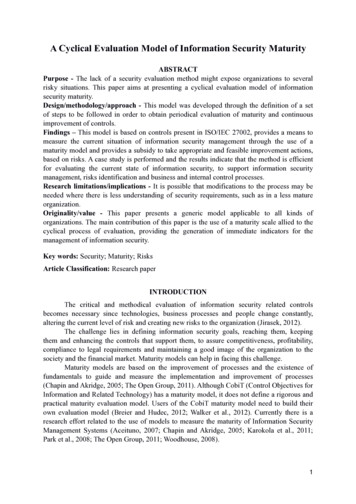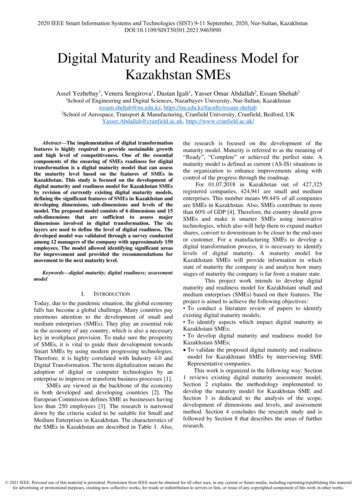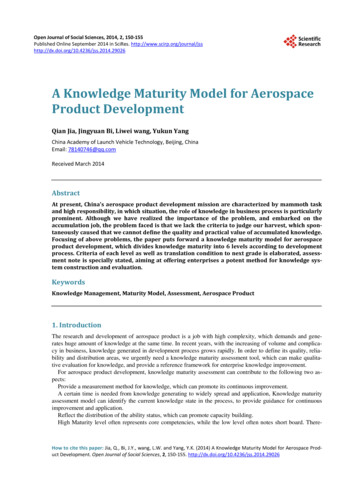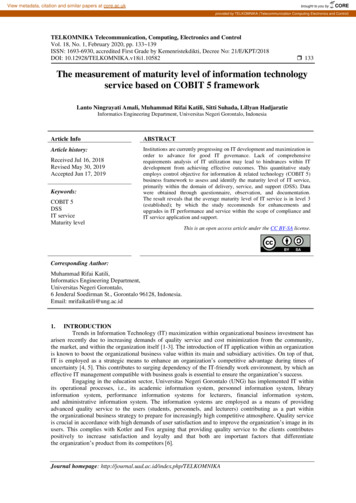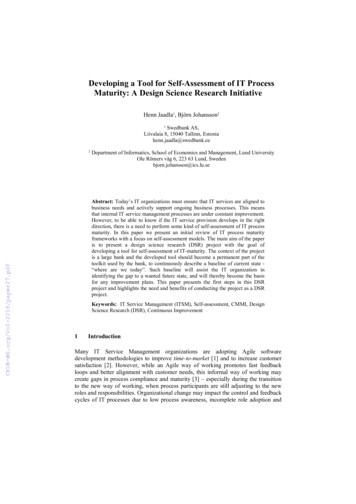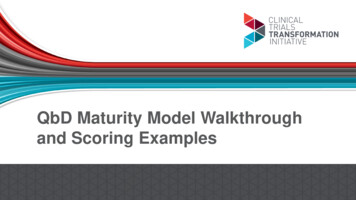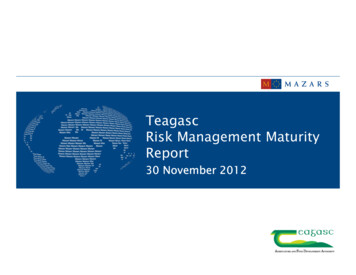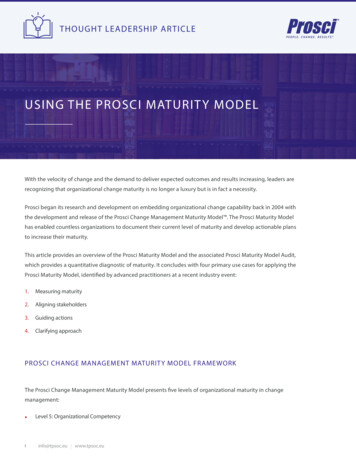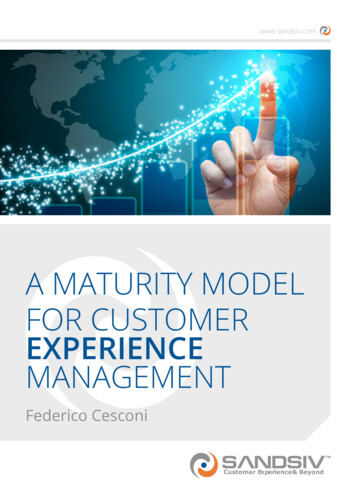
Transcription
www.sandsiv.comA MATURITY MODELFOR CUSTOMEREXPERIENCEMANAGEMENTFederico CesconiTM Customer Experience & Beyond1
www.sandsiv.comTMCustomer Experience & BeyondLegal Notice: Sandsiv 2014. All Rights Reserved.The information contained with the document is givenin good faith and is believed to be accurate, appropriateand reliable at the time it is given, but is provided withoutany warranty of accuracy, appropriateness or reliability.The author does not accept any liability or responsibilityfor any loss suffered from the reader’s use of the advice,recommendation, information, assistance or service, tothe extent available by law.2
www.sandsiv.comCONTENTSFIRST STEPS TOWARDS CEM MATURITY4LEGACY TECHNOLOGIES AND METHODOLOGIES5TECHNOLOGY DRIVES CEM MATURITY8THE GARTNER CEM MATURITY MODEL11CONCLUSIONS20ABOUT THE AUTHOR21BIBLIOGRAPHY22ABOUT SANDSIV23 3
www.sandsiv.comFIRST STEPS TOWARDSCEM MATURITYWhen setting out along the road towards an enterprise wide CustomerExperience Management (CEM) solution, it is vital to map the entire journeybeforehand. You may know where you wish to go, but you need to plancarefully how to get there, and this includes understanding your starting point fully.Within this document you will find abasic road map and strategy for takinga company’s current CEM (or lack of it)methodology and developing a mature,valuable set of processes which will enablethe company to excel in its CEM endeavors.CEM is an emerging strategy andcorresponding set of business practices,so it is not surprising that a vast majorityof companies are still in the earlystages of adopting CEM (more than ⅔).Alongside this, there seems to be a widegap in service delivery quality betweencompanies that have no, or very few,CEM strategies in place, and those thatare well along the road to adoptingCEM enterprise wide. Technology is thekey to closing this gap for companiesthat wish to take the fast track to CEMimplementation. The kind of technologythat delivers real time insights, byinterrogating both structured and4 unstructured data, streams acrossmultiple channels.SandSIV is able to help every enterprisenavigate the road to CEM maturity,assisting at every stage. SandSIV deliverstechnology solutions that facilitate theadoption of CEM as a business tool acrossthe entire enterprise.SandSIV is able to help everyenterprise navigate the road toCEM maturity, assisting at every stage.”
www.sandsiv.comLEGACY TECHNOLOGIESAND METHODOLOGIESThere are two outdated sets of business processes which are still usedby many organizations, and which have now been superseded by CEM.Both, Customer Relationship Management (CRM) and Enterprise FeedbackManagement (EFM), have been proven to be less effective than CEM at every level.CRM - Ineffective and OutdatedCRM was first developed as a method ofmaintaining the customer relationshipmore than two decades ago. Duringthis period, many organizations haveinvested heavily into both, technologyand operationalchanges, to implementa viable CRM solution. Unfortunately,despite this investment, the customerrelationship has not improved in linewith the investment made.The limitation of CRM is that themethods used to capture customeropinions are limited, and the data onceaccrued is not shared across the entireorganization, so valuable data is notbeing exploited to its fullest.When faced with the fact that anexpensive CRM solution is not deliveringthe expected boost to the customerrelationship, many companies havechosen to attempt to augment the failingCRM initiate by rolling out an EFM systemby additionally rolling out.The limitation of CRM is thatthe methods used to capturecustomer opinions are limited.” 5
www.sandsiv.comEFM - Simply not EnoughAs explained above, CRM does notencourage the sharing of data across theentire enterprise. EFM is often employedalongside CRM to overcome this problem.EFM enables the company to build awarehouse of gathered customer data,which have been obtained via CRM andwhich can be interrogated in many ways.Although this is an improvement, thereis still a specific problem with combiningCRM with EFM. All feedback, which hasbeen warehoused and shared across theorganization, has only been gatheredin a single fashion, and this is when thecustomers are aware that they are givingfeedback. This is an underlying problemwith CRM, not with EFM, but it is stilllimiting the effectiveness of EFM.From Capturing Feedback to Listening tothe Voice of the CustomerThere are three broad channels ofcustomer feedback: DirectIndirectInferredDirect is when the customer is givingconscious feedback to the organization,typically through a survey or complaint.Indirect is when the customeris providing feedback about theorganization, but it is not direct feedbackto that organization. It’s about them, butnot to them. This could include socialmedia like Twitter or Facebook.6
www.sandsiv.comThe third category is the inferred area,where customers are not actually tellingyou something specifically, but it can bedetermined based on operational dataassociated with the experience. This couldinclude IVR click stream, hold time, or anyother operational data that gives clues tohow the customer’s experience went.The only effective way to eliminatethe shortcomings of CRM, EFM or acombination of the two, is to commit toCEM, and implement a company-widestrategy, which is actioned via a VoC Hub(F.Cesconi, 2012, ‘The customer has avoice, listen to it all times’).We define the Customer Intelligencecoming from these 3 different channels asVoice of the Customer (VoC).CRM & EFM - Combined donot Capture Every VoiceAny solution which is intended to captureand act upon the VoC needs to encompassall three categories. CRM & EFM combinedonly capture the direct VoC and entirelyignore the indirect and inferred voices. 7
www.sandsiv.comTECHNOLOGY DRIVESCEM MATURITYBy implementing a feature rich VoC Hub, a companycan progress along the road to CEM maturity muchmore quickly.A VoC Hub provides the company with thetechnology required to deliver a singleplatform, which is capable of reporting onthe status of the customer relationshipin real time. This is a critical tool forensuring that a swift route to a matureCEM model is taken.A fully unified VoC Hub can gathercustomer feedback across multiplechannels, locations and touch points. Thisincludes both, online and offline channels,along with structured and unstructureddata sources.Once a VoC Hub is in place, the companywill begin to benefit from a muchclearer, 360 degree view of the customerA fully unified VoC Hubcan gather customerfeedback across multiple channels,locations and touch points.”8 relationship. The VoC Hub becomes anextremely agile tool for distributing andactioning feedback across the entireenterprise. This leads to tangible andmeasurable results very quickly, resultingin a very short lead-time to hit ROI.The Path to CEM Maturity - Why CEM?There are a number of factors that haveled to the development of CEM as astrategy for businesses to extract value
www.sandsiv.comfrom the relationship to their customers.These include:-- Large companies all tend to showa similar shape in operations,meaning less individuality. CEMcan be used as a vehicle forportraying uniqueness within themarketplace.-- Modern customers are betterinformed, with a wide range of toolsavailable to help evaluate products/services on offer. This results in apropensity for customers to switchbrands or suppliers.-- Statistics show that companies whichexcel in the area of the customerexperience post greater profits, anda much faster ROI, alongside otherfinancial benefits.-- Social media/networking and otherforms of communication technologymake it very easy for customersto negatively affect the reputationof a company/product/brand in avital manner.-- Overall, CEM allows a company toextract value from the customerrelationship by raising the ratioof customer retention, leveragingcustomer advocacy to generatepositive opinion, gain a larger shareof the customer wallet and lower thecost of marketing.Typically, most companies will operateseveral projects, which combine toproduce the overall CEM initiative. Theseprojects will vary in timescale from a fewweeks for issues such as streamlining thecompany website to be more customercentric, to several years in the case oforganizational restructuring and stafftraining. Additionally, many of theseprojects will be self-iterating, and, ineffect, become permanent businessprocesses in their own right. Due tothe complexity and scope of a full CEMinitiative, most companies find it a toughchallenge. The Gartner CEM maturitymodel is designed to help businessesdefine their current CEM position, andplan a route forward. The Gartner CEMmaturity model can assist with: 9
www.sandsiv.com-- Boosting the awareness of CEMwithin the organization, as well asthe business benefits to be gained byinvesting in CEM-- Assessing and evaluating thecompany’s current CEM position (orlack of it), and making comparisonsbetween perceived best practices,creating a starting point from whichthe company can begin its journeytowards CEM maturity-- Defining a set of long term goalswhich the company will work towards,10 which will provide an effectivetechnological and organizationalmodel and which will permanentlyimprove the customer’s experience-- Producing a strategic planningmap for the prioritization of allCEM related projects across theentire enterprise-- Defining a clear set of steps to betaken to move the company forwardtowards its long term CEM goals
www.sandsiv.comTHE GARTNER CEM MATURITY MODELThere are two outdated sets of business processes which are still usedby many organizations, and which have now been superseded by CEM.Both, Customer Relationship Management (CRM) and Enterprise FeedbackManagement (EFM), have been proven to be less effective than CEM at every level.What is the Customer Experience?Before we take the first step along theroad to CEM maturity, it is important thatwe understand exactly what we mean bycustomer experience. We could defineit as follows: Customer experience isthe real-time, cumulative opinions andfeelings of the customers towards thebusiness/brand/product. It is influencedby every interaction with the companyacross every channel.We can further define CEM as a setof operational methods/procedureswhich will monitor the opinions andfeelings of the customer and actupon the insights gained to refine theCustomer experience is thereal-time, cumulative opinionsand feelings of the customers towardsthe business/brand/product.”customer experience, which will raisethe customer’s levels of advocacy,satisfaction and loyalty.The Five Stages of CEMThe Gartner CEM maturity modelrecognizes five distinct stages of CEMmaturity, namely initial, developing,defined, managed and optimized. Globalcommercial metrics indicate that themajority of large scale businesses arecurrently operating at stage 1, the initialstage, or stage 2, the developing stageof CEM maturity, and are progressingtowards stage 3, the defined stage. 11
www.sandsiv.comThere is one additional stage of CEMmaturity which falls outside of thisroadmap. We refer to it as the zero stage,and this is used to define companieswhich have no CEM initiative in place,have no plans to implement one, andare possibly entirely unaware of theexistence of CEM.Stage 1 - The Initial StageThe company’s CEM strategy isentirely fragmented, with no or littledefinition in terms of goals or perceivedrequirements. In most cases, businessprocesses are not coordinated acrossdepartments, customer information isnot shared and little value is placed uponthe quality of the customer experience.Furthermore, there is no advocacy ofCEM at decision making levels, and thereis zero buy in from key stakeholders. Atstage 1 we see the following indicators:-- There is no overall vision of CEM atgrass roots level; there is no supportor budgetary allocation to facilitate anyform of CEM initiative being launched.-- There is no CEM strategy in place,and there is very little understandingof the value of CEM, as well as no12
www.sandsiv.comprocess in place for evaluating theeffectiveness of the competitors’ CEM.-- There is no system or tool formeasuring customer metrics, andthere is no capacity for tailoring thecustomer experience based uponsuch metrics to improve the customerrelationship.-- There is no CEM framework or set ofbest practices in place to standardizeCEM policies and processes. CEMdoes not form a part of the decisionStage 2 - The Developing StageIn stage 2 of the CEM maturity roadmap,the company has identified the valueof CEM, and has begun to take stepstowards deploying a unified solution. Thecurrent initiatives which gather or actupon customer feedback will have beenreviewed and documented.making process.-- There is no process for assigningownership of the customerexperience, and no person ordepartment is tasked with the job ofmaintaining it.-- There are no common businessprocesses which operate acrossdepartments in place to manage thecustomer experience.-- There is no technology in place togather customer experience data,store it, analyze it, or act upon it inany form.the responsibility of a clearly definedindividual or group and a plan fordevelopment will have been agreed on.Shortcomings will have been highlightedand a range of improvements will havebeen planned. CEM will have becomeIn stage 2 of the CEM maturityroadmap, the company hasidentified the value of CEM, andhas begun to take steps towardsdeploying a unified solution.” 13
www.sandsiv.comHowever, in stage 2, the company isstill only just beginning its journeytowards CEM maturity. Although thebenefits of CEM may be apparent togroups/departments, there will be noexecutive buy in. Due to this situation,individual groups will be actioning theirown independent initiatives, whichcontradicts the need for a unified,enterprise wide CEM solution. Availabletools which capture or action customerfeedback will not share a common datarepository, and will not be available toevery department. Typically, a companyin stage 2 of CEM maturity will exhibit thefollowing indicators:-- No executive advocacy of CEM as along term goal, with multiple groupsworking upon their own CEM projects,lacking unity.-- No unified strategy for developingthe company’s CEM capabilitieswill exist and departments will beworking at departnemt level to tackleCEM problems as they arise, reactingrather than taking action.-- No set of standard customer metricswill have been defined which thecompany as a whole can use asteering mechanism.-- Instead, localized small groups willbe working with separate, oftenconflicting metrics.14 -- No companywide CEM frameworkwill have been agreed on andstandardized across the business,with the divergence of separatedepartmental CEM initiatives causinggovernance problems.-- A CEM team will have beenestablished, which at this stage willsolely be tasked with developing aview of the customer experiencebased upon customer feedback.-- Mapping of business processes whichimpact the customer experience willhave begun.-- Current technologies which are usedto manage the customer experiencewill have been identified. Thisincludes CRM systems, call centerand call logging systems, and tertiarytechnologies such as billing, deliveryand ordering.
www.sandsiv.comStage 3- The Defined StageStage 3 is possibly the most critical stagein the Gartner CEM maturity model, as itis at this stage that executive advocacy isobtained. Senior management and keydecision makers will have clearly outlinedthe company’s CEM agenda, and theorganization will be aware of it. Short,medium and long term goals will havebeen defined and a set of standardizedprocesses designed to furtherseparate projects associated with CEM.Governance boundaries will be in placeand some form of compliance tracking ineffect. Typical indicators that a companyhas reached stage 3 of CEM maturity are:-- CEM is recognized as a criticalrequirement for the business byexecutives and senior management,and is now being proactively drivenby these two key groups.CEM is recognized as a criticalrequirement for the business byexecutives and senior management.” 15
www.sandsiv.com-- Individual departments are now CEMaware, and a finalized audit of all of thecompany’s current CEM strategies hasbeen finalized, and plans are in place toextend, replace and improve them.-- A companywide set of standardcustomer metrics have been agreedupon, to be used as the measure ofCEM effectiveness.-- Although these metrics are still nottracked and actioned via a unifiedVoC Hub.-- However individual departments arestill managing their own separateCEM initiatives on a day to day basis,a companywide CEM framework hasbeen agreed upon and the companyis moving towards a single, centrallygoverned CEM initiative which willunify separate departmental projects.-- A senior person has been chargedwith the overall CEM initiative, and ateam or task force is in place to steerthe company’s CEM project as a whole.-- The company will have defined themajor business processes whichaffect the customer relationship andwill have begun to engineer the mostproblematic of these to be morecustomer centric.-- Technology will begin to evolve, as afull understanding of the limitationsof the current systems has nowbeen reached. as well as a clearset of requirements for future CEMtechnologies to fulfill.The customer experienceis now driven by a set ofclearly defined processes andmanaged by capable systems.”16
www.sandsiv.comStage 4 - The Managed StageBy stage 4, the company is not onlysubscribed to CEM as a future tool whichwill help it get ahead in the marketplace;moreover, it has already begun to reappositive rewards from the CEM strategyimplementation. All employees areaware of the importance of CEM, andare actively encouraged to act in a morecustomer centric manner, as well asgiven the training and tools to do so. Thecustomer experience is now driven bya set of clearly defined processes andmanaged by capable systems. Typically,a company which is in stage 4 of its CEMmaturity will be identified as having thefollowing traits:-- A solid, unified vision of CEM as avaluable business tool has been--------adopted by the board of directors,and is prominent in their goals anddriven forward by the executives.There is a unified CEM strategy inplace, and fragment CEM initiativesat departmental level have been jointinto a single overall CEM policy.Customer experience metrics havegone through one or more iterativeevaluations and been refined andperfected to fit the business, and arenow solidly standardized across theenterprise.All departmental or group drivenprojects are now unified under asingle governance group, whichis responsible for pushing CEMstrategies forward yet maintainingunity.The CEM team is now operating at 17
www.sandsiv.coma more advisory level, as individualdepartments are now up to speedon the processes and strategiesemployed in CEM. The team offersadvice and steering as opposed tototal direction and control.-- The company has identified most ofthe business processes which affectthe customer relationship and hasmade significant progress in changingthem to be more customer centric,and in line with the company’sstandardized CEM governance model.-- Technology is now being modified/ extended to unify data in a singlewarehouse which is accessibleacross the entire business.Significant headway has been madetowards utilizing customer datato create a 360 degree view of thecustomer experience.18
www.sandsiv.comStage 5 - The Optimized StageStage 5, the optimized stage, is asignificant milestone along the road toCEM maturity. By this stage, CEM hasbeen adopted as a working culture,not simply a set of standards whichemployees are expected to work to.There is no requirement for incentivesor rewards to promote good customercentric behavior or working practices, andemployees are now empowered to make theresponsible for monitoring the company’sCEM position, whilst exploring new waysto improve it, and evaluating the CEMstrategies employed by competitors.Overall, the entire culture of the companywill have changed to become focusedon the customer experience in a way itnever has previously, and benefits can beseen by everyone, at every touch pointbetween the customer and the company.best effort towards improving the customerexperience using their own initiative.A complete, holistic, 360 degree viewof the customer experience is nowavailable, by using a unified VoC Hubto interrogate a single data warehouse.All governance requirements and theworking practices generated are nowfirmly ingrained in the day to dayworking practices of every departmentand employee.The company recognizes it has achievedsome exceptional results with its CEMinitiative so far, but also realizes that itmust continue to refine its CEM strategyto adapt to market changes, and the everevolving voice of the customer.The CEM steering team has moved intoa much less proactive role, and is now 19
www.sandsiv.comCONCLUSIONSThe Gartner CEM MaturityModel as an IndicatorThe CEM maturity model outlined aboveis by no means definite, yet it is a fairdescription of the state of CEM acrossthe clearly identifiable five stages of CEMmaturity with a majority of companies.Our best advice to all companies is to usethe CEM maturity model that SandSIV hasoutlined as a yardstick to judge your owncompany’s stage along the road to CEMmaturity. However, some companies willfind that they are standing between twostages, or exhibit traits found in severalstages. No two companies are alike, andalthough this model for CEM maturitycan serve as a guideline, it should not beseen as a definitive set of instructions toachieve CEM maturity.No two companies are alike,and although this modelfor CEM maturity can serve as aguideline, it should not be seenas a definitive set of instructionsto achieve CEM maturity.”20
www.sandsiv.comABOUT THE AUTHORFederico Cesconi is the CEOand IT Visionary of SandSIVPrior to joining SandSIV, he was Directorof Business Intelligence at Cablecom andUPC. There he was responsible for thedevelopment and implementation ofbest practices for Customer ExperienceManagement and business insight acrossthe organization.Federico has more than 15 years ofexperience in marketing analytics. He servedas the Marketing Manager at Tinet SA, oneof Southern Switzerland’s leading InternetService Providers, where he was responsiblefor database marketing and data mining.After joining Cablecom Ticino in 2000 asMarketing Manager, in 2002 he movedCablecom corporate headquartersin Zurich as the Head of CustomerInformation Management.Federico has won the North AmericanInsight Award 2006 in Data Mining, theEuropean Insight Award 2007, and the 1-to1 Gartner Award 2008. Federico earned aMaster’s in Business Administration fromthe University of Wales.Using the CEM Frameworkallows a business tocontinuously improve customerexperiences in ways thatultimately builds customersatisfaction and loyalty.” 21
www.sandsiv.comBIBLIOGRAPHYDavey N. (2012), The hybrid hub: Sevensteps to a single view of the customer voice,MyCustomer.com.Protopapa F. (2012), Voice of the CustomerMaturity Model to Support the NewIntelligence Enterprise Strategy, Universityof Wales - Robert Kennedy College.Davies J. (2012), Listen the Voice of theCustomer, Even When It’s not Directed toYou, Gartner CRM Summit, Orlando, FL.Schorah K. (2011), Voice of the CustomerTrends for 2011, isnare.com.Goodwin B. (2011), Video: Gartner urgesbusiness to integrate social media and CRM,video with Jim Davies, Analyst at Gartner Inc.Thompson E. (2012), The CustomerExperience Scenario, Gartner CRM Summit,Orlando, FL.LaDove B. (2005), Leveraging the Voice ofthe Customer, LaDove Associates.22
www.sandsiv.comABOUT SANDSIVSandSIV enables world leading companies to gather superior customerintelligence. Through its purpose-built modular SaaS solution and expertCustomer Experience Management (CXM) and Voice of the Customer (VoC)consulting, SandSIV is a recognized global leader in VoC and CXM. SandSIV solutionsdirectly contribute to increased operational efficiency, help accelerate businessperformance and provide measurable impact on revenues and the bottom-line.SandSIV operates globally and specializesin the following industry verticals:Automotive, Entertainment, Financials,Hospitality, Media, Retail, Telecoms,Transport and Utilities. The companyis headquartered in Switzerland withrepresentative offices and distributionpartners across EMEA.enables a real business transformationtowards a customer-centric businessmodel – underpinned with our passion todeliver superior customer intelligence.TMSandSIV empowers its clients with theability to understand their customersfaster and more intimately than theircompetitors and to utilize customerintelligence to drive continuousimprovements within their organization.By closing the gap between theircustomers’ expectations and the deliveryexperience, SandSIV provides its clientswith a complete VoC solution to supporta holistic CXM business strategy. SandSIVCustomer Experience & BeyondHEAD OFFICESandSIV Ltd.Binzstrasse 238045 ZürichSwitzerlandPhone: 41 44 687 87 67Email: info@sandsiv.com 23
TMCustomer Experience & Beyondw ww.sandsiv .com
customer experience, which will raise the customer's levels of advocacy, satisfaction and loyalty. The Five Stages of CEM The Gartner CEM maturity model recognizes five distinct stages of CEM maturity, namely initial, developing, defined, managed and optimized. Global commercial metrics indicate that the majority of large scale businesses are


